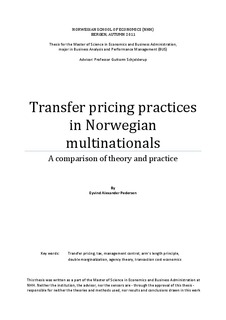Transfer pricing practices in Norwegian multinationals : a comparison of theory and practice
Master thesis
Permanent lenke
http://hdl.handle.net/11250/169413Utgivelsesdato
2011Metadata
Vis full innførselSamlinger
- Master Thesis [4372]
Sammendrag
During the last two decades there has been an increasing focus on transfer pricing both from firms and authorities. Today, many CFOs identify transfer pricing as their most important tax issue, and more and more countries realise that there are considerable tax revenues that could be collected from a stricter enforcement of the transfer pricing legislation. When looking at the academic literature, however, one will see that transfer pricing is an issue that spans much wider than the firm’s tax report, and, if used correctly, it can be a very efficient tool for management control. With this background, this master thesis sets out to study the differences between the advice given about transfer pricing in the academic literature and the practices that can be observed in Norwegian multinational firms. Emphasis is put on how the practices are impacted by tax legislation.
Due to the current globalisation, transfer pricing is an issue that constantly increase in importance. The world is becoming more interconnected and both the number of multinational enterprises and the level of intra-firm cross-border trade are growing. This trend makes it both interesting and important to get an understanding of how firms approach the issue of pricing their internal transfers, in order to identify improvements that could increase the efficiency of firms and legislation.
In the first part of this master thesis we conduct a literature study to get a proper understanding of the transfer pricing problem and its implications. In the second part we turn our attention to the transfer pricing practices in Norwegian firms. Here, we first create a set of research hypotheses about the transfer pricing practices in Norway based on the literature study and former empirical studies of transfer pricing practices. We then test our hypotheses through a survey that is sent out to four transfer pricing advisory consultants. The consultants answer the survey based on their observations from more than 150 Norwegian firms. The result being that five out of the six research hypotheses are confirmed or partly confirmed. In the third and final part, the results from the study of practices are compared with findings from the literature study, to say something about the differences between theory and the practices in Norwegian firms.
The results of our analyses show that, when it comes to transfer pricing, there are considerable differences between the advice given in the academic literature and the practices observed in Norwegian multinationals. While theory suggests that a firm should use transfer pricing for both strategic optimisation, including management control, and tax optimisation, the study of practices shows that firms in Norway almost exclusively are concerned with complying with the tax legislation. Thus, our results show that tax legislation has a fairly big impact on the observed practices in Norwegian firms.
P a g e | 2
Important to notice here is that the transfer pricing legislation in Norway is quite new, and my research suggests that Norwegian firms could have had an even less structured approach to transfer pricing before the new legislation came into effect in January 2008.
When looking at the countries that are leading within transfer pricing, we can see that they have had legislation in the area for more than a decade. The development in these countries suggests that as time passes by and firms mature in their view and understanding of transfer pricing, strategic considerations are also adopted as a part of their transfer pricing policy. This leads us to believe that, in the long term, Norwegian firms will also adopt a more mature approach to transfer pricing, an approach that is more congruent with the advice given in the academic literature. As a conclusion to this master thesis, I make five proposals for improvements that will help accelerate the maturation process for Norwegian firms.
